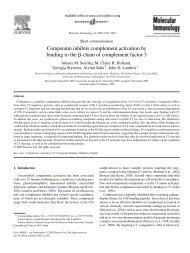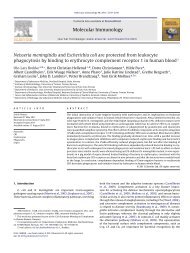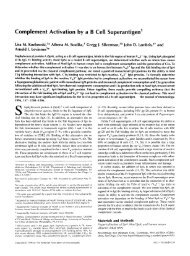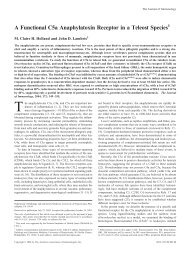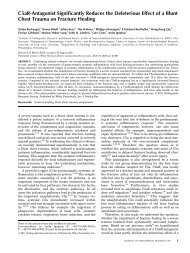Hydrophobic Effect and Hydrogen Bonds Account for the Improved ...
Hydrophobic Effect and Hydrogen Bonds Account for the Improved ...
Hydrophobic Effect and Hydrogen Bonds Account for the Improved ...
Create successful ePaper yourself
Turn your PDF publications into a flip-book with our unique Google optimized e-Paper software.
4622 Journal of Medicinal Chemistry, 2006, Vol. 49, No. 15 Katragadda et al.<br />
antigen-antibody complex-mediated complement activation of<br />
human serum, as detected by <strong>the</strong> deposition of C3b/iC3b to<br />
complex, in <strong>the</strong> presence of <strong>the</strong> compstatin analogue. The absorbance<br />
data obtained at 405 nm were translated into percent<br />
inhibition based on <strong>the</strong> absorbance corresponding to 100% complement<br />
activation. The percent inhibition was plotted against <strong>the</strong><br />
peptide concentration, <strong>and</strong> <strong>the</strong> resulting data set was fit to <strong>the</strong><br />
logistic dose-response function by use of Origin 7.0 software. IC 50<br />
values were obtained from <strong>the</strong> fitted parameters that achieved <strong>the</strong><br />
lowest χ 2 value. Plots of IC 50 versus log P were drawn by use of<br />
Origin 7.0 software. Log P values <strong>for</strong> tryptophan, 5-fluorotryptophan,<br />
5-methyltryptophan, 1-methyltryptophan, <strong>and</strong> 2-naphthylalanine<br />
were calculated in JME molecular editor (www.molinspiration.com)<br />
from <strong>the</strong> structures shown in Figure 1.<br />
Iso<strong>the</strong>rmal Titration Calorimetric Analysis of <strong>the</strong> Interaction<br />
of C3 with Compstatin <strong>and</strong> Its Analogues. Iso<strong>the</strong>rmal titration<br />
calorimetry experiments were per<strong>for</strong>med with <strong>the</strong> Microcal VP-<br />
ITC calorimeter (Microcal Inc., Northampton, MA). Protein<br />
concentrations of 3.5-5 µM <strong>and</strong> peptide concentrations of 80-<br />
200 µM were used <strong>for</strong> <strong>the</strong>se experiments. All titrations were<br />
per<strong>for</strong>med in PBS (10 mM phosphate buffer with 150 mM NaCl,<br />
pH 7.4). In each experiment, <strong>the</strong> target protein, C3, was loaded<br />
into <strong>the</strong> cell, <strong>and</strong> peptide was loaded into <strong>the</strong> syringe. All<br />
experiments were per<strong>for</strong>med at 25 °C, <strong>and</strong> <strong>for</strong> each experiment,<br />
2-µL peptide injections were made into <strong>the</strong> cell containing <strong>the</strong><br />
protein. In each experiment, <strong>the</strong> raw iso<strong>the</strong>rms were corrected <strong>for</strong><br />
<strong>the</strong> heats of dilution by subtracting <strong>the</strong> iso<strong>the</strong>rms representing<br />
peptide injections into <strong>the</strong> buffer. The resulting iso<strong>the</strong>rms were fit<br />
to various models by use of Origin 7.0 software, <strong>and</strong> <strong>the</strong> model<br />
that achieved <strong>the</strong> lowest χ 2 value was deemed to be appropriate<br />
<strong>for</strong> <strong>the</strong> respective data set. The binding affinity <strong>and</strong> entropy values<br />
were plotted against log P values by use of Origin 7.0 software.<br />
Acknowledgment. We thank Charissa Wiley, Stacy Feinsot,<br />
<strong>and</strong> Lynn Spruce <strong>for</strong> <strong>the</strong>ir help with peptide syn<strong>the</strong>sis <strong>and</strong> HPLC<br />
purification <strong>and</strong> Lang Fang <strong>for</strong> her help with C3 purification.<br />
We also thank Dr. Piet Gros <strong>and</strong> Bert J. C. Janssen (Utrecht)<br />
<strong>and</strong> Dr. Michael Schuster (Penn) <strong>for</strong> critically reading <strong>the</strong><br />
manuscript <strong>and</strong> Deborah McClellan <strong>for</strong> editorial assistance. This<br />
work was supported by NIH Grants GM 62134 <strong>and</strong> GM 069736.<br />
References<br />
(1) Soulika, A. M.; Holl<strong>and</strong>, M. C. H.; Sfyroera, G.; Sahu, A.; Lambris,<br />
J. D. Compstatin inhibits complement activation by binding to <strong>the</strong><br />
[β]-chain of complement factor 3. Mol. Immunol. 2006, 43, 2023-<br />
2029.<br />
(2) Mastellos, D.; Lambris, J. D. Complement: more than a ′guard′<br />
against invading pathogens? Trends Immunol. 2002, 23, 485-491.<br />
(3) Sahu, A.; Kay, B. K.; Lambris, J. D. Inhibition of human complement<br />
by a C3-binding peptide isolated from a phage-displayed r<strong>and</strong>om<br />
peptide library. J. Immunol. 1996, 157, 884-891.<br />
(4) Nilsson, B.; Larsson, R.; Hong, J.; Elgue, G.; Ekdahl, K. N.; et al.<br />
Compstatin inhibits complement <strong>and</strong> cellular activation in whole<br />
blood in two models of extracorporeal circulation. Blood 1998, 92,<br />
1661-1667.<br />
(5) Fiane, A. E.; Mollnes, T. E.; Videm, V.; Hovig, T.; Hogasen, K.; et<br />
al. Compstatin, a peptide inhibitor of C3, prolongs survival of ex<br />
vivo perfused pig xenografts. Xenotransplantation 1999, 6, 52-65.<br />
(6) Soulika, A. M.; Khan, M. M.; Hattori, T.; Bowen, F. W.; Richardson,<br />
B. A.; et al. Inhibition of heparin/protamine complex-induced<br />
complement activation by Compstatin in baboons. Clin. Immunol.<br />
2000, 96, 212-221.<br />
(7) Mollnes, T. E.; Brekke, O. L.; Fung, M.; Fure, H.; Christiansen, D.;<br />
et al. Essential role of <strong>the</strong> C5a receptor in E. coli-induced oxidative<br />
burst <strong>and</strong> phagocytosis revealed by a novel lepirudin-based human<br />
whole blood model of inflammation. Blood 2002, 100, 1869-<br />
1877.<br />
(8) Morikis, D.; Assa-Munt, N.; Sahu, A.; Lambris, J. D. Solution<br />
structure of Compstatin, a potent complement inhibitor. Protein Sci.<br />
1998, 7, 619-627.<br />
(9) Morikis, D.; Roy, M.; Sahu, A.; Troganis, A.; Jennings, P. A.; et al.<br />
The structural basis of compstatin activity examined by structurefunction-based<br />
design of peptide analogues <strong>and</strong> NMR. J. Biol. Chem.<br />
2002, 277, 14942-14953.<br />
(10) Klepeis, J. L.; Floudas, C. A.; Morikis, D.; Tsokos, C. G.; Argyropoulos,<br />
E. et al. Integrated computational <strong>and</strong> experimental approach<br />
<strong>for</strong> lead optimization <strong>and</strong> design of compstatin variants with improved<br />
activity. J Am Chem Soc 2003, 125, 8422-8423.<br />
(11) Mallik, B.; Katragadda, M.; Spruce, L. A.; Carafides, C.; Tsokos,<br />
C. G. et al. Design <strong>and</strong> NMR characterization of active analogues of<br />
compstatin containing nonnatural amino acids. J Med Chem 2005,<br />
48, 274-286.<br />
(12) Katragadda, M.; Lambris, J. D. Expression of compstatin in Escherichia<br />
coli: Incorporation of unnatural amino acids enhances its<br />
activity. Protein Expression Purif. 2006, 47, 289-295.<br />
(13) Umezawa, Y.; Nishio, M. CH/[π] interactions in <strong>the</strong> crystal structure<br />
of class I MHC antigens <strong>and</strong> <strong>the</strong>ir complexes with peptides. Bioorg.<br />
Med. Chem. 1998, 6, 2507-2515.<br />
(14) Matsushima, A.; Fujita, T.; Nose, T.; Shimohigashi, Y. Edge-to-face<br />
CH/ π interaction between lig<strong>and</strong> Phe-phenyl <strong>and</strong> receptor aromatic<br />
group in <strong>the</strong> thrombin receptor activation. J. Biochem. (Tokyo) 2000,<br />
128, 225-232.<br />
(15) Beene, D. L.; Br<strong>and</strong>t, G. S.; Zhong, W.; Zacharias, N. M.; Lester,<br />
H. A.; et al. Cation-π interactions in lig<strong>and</strong> recognition by<br />
serotonergic (5-HT3A) <strong>and</strong> nicotinic acetylcholine receptors: <strong>the</strong><br />
anomalous binding properties of nicotine. Biochemistry 2002, 41,<br />
10262-10269.<br />
(16) Zacharias, N.; Dougherty, D. A. Cation-π interactions in lig<strong>and</strong><br />
recognition <strong>and</strong> catalysis. Trends Pharmacol. Sci. 2002, 23, 281-<br />
287.<br />
(17) Choi, H. S.; Suh, S. B.; Cho, S. J.; Kim, K. S. Ionophores <strong>and</strong><br />
receptors using cation-π interactions: collarenes. Proc. Natl. Acad.<br />
Sci. U.S.A. 1998, 95, 12094-12099.<br />
(18) Schiefner, A.; Breed, J.; Bosser, L.; Kneip, S.; Gade, J.; et al. Cation-<br />
{π} Interactions as Determinants <strong>for</strong> Binding of <strong>the</strong> Compatible<br />
Solutes Glycine Betaine <strong>and</strong> Proline Betaine by <strong>the</strong> Periplasmic<br />
Lig<strong>and</strong>-binding Protein ProX from Escherichia coli. J. Biol. Chem.<br />
2004, 279, 5588-5596.<br />
(19) Katragadda, M.; Morikis, D.; Lambris, J. D. Thermodynamic Studies<br />
on <strong>the</strong> Interaction of <strong>the</strong> Third Complement Component <strong>and</strong> Its<br />
Inhibitor, Compstatin. J. Biol. Chem. 2004, 279, 54987-54995.<br />
(20) Xiao, G.; Parsons, J. F.; Tesh, K.; Armstrong, R. N.; Gillil<strong>and</strong>, G.<br />
L. Con<strong>for</strong>mational changes in <strong>the</strong> crystal structure of rat glutathione<br />
transferase M1-1 with global substitution of 3-fluorotyrosine <strong>for</strong><br />
tyrosine. J. Mol. Biol. 1998, 281, 323-339.<br />
(21) Abbate, F.; Casini, A.; Scozzafava, A.; Supuran, C. T. Carbonic<br />
anhydrase inhibitors: X-ray crystallographic structure of <strong>the</strong> adduct<br />
of human isozyme II with <strong>the</strong> perfluorobenzoyl analogue of methazolamide.<br />
Implications <strong>for</strong> <strong>the</strong> drug design of fluorinated inhibitors.<br />
J. Enzyme Inhib. Med. Chem. 2003, 18, 303-308.<br />
(22) Lee, S.; Lin, X.; McMurray, J.; Sun, G. Contribution of an active<br />
site cation-π interaction to <strong>the</strong> spectroscopic properties <strong>and</strong> catalytic<br />
function of protein tyrosine kinase Csk. Biochemistry 2002, 41,<br />
12107-12114.<br />
(23) Umezawa, Y.; Nishio, M. CH/[π] Interactions as demonstrated in<br />
<strong>the</strong> crystal structure of guanine-nucleotide binding proteins, Src<br />
homology-2 domains <strong>and</strong> human growth hormone in complex with<br />
<strong>the</strong>ir specific lig<strong>and</strong>s. Bioorg. Med. Chem. 1998, 6, 493-504.<br />
(24) Umezawa, Y.; Tsuboyama, S.; Takahashi, H.; Uzawa, J.; Nishio, M.<br />
CH/[π] interaction in <strong>the</strong> con<strong>for</strong>mation of peptides. A database<br />
study+. Bioorg. Med. Chem. 1999, 7, 2021-2026.<br />
(25) Basran, J.; Mewies, M.; Ma<strong>the</strong>ws, F. S.; Scrutton, N. S. Selective<br />
modification of alkylammonium ion specificity in trimethylamine<br />
dehydrogenase by <strong>the</strong> rational engineering of cation-π bonding.<br />
Biochemistry 1997, 36, 1989-1998.<br />
(26) Janssen, B. J. C.; Huizinga, E. G.; Raaijmakers, H. C. A.; Roos, A.;<br />
Daha, M. R.; et al. Structures of complement component C3 provide<br />
insights into <strong>the</strong> function <strong>and</strong> evolution of immunity. Nature 2005,<br />
437, 505-511.<br />
(27) Sahu, A.; Soulika, A. M.; Morikis, D.; Spruce, L.; Moore, W. T.; et<br />
al. Binding kinetics, structure-activity relationship, <strong>and</strong> biotrans<strong>for</strong>mation<br />
of <strong>the</strong> complement inhibitor compstatin. J. Immunol. 2000,<br />
165, 2491-2499.<br />
(28) Meyers, C. A.; Coy, D. H.; Huang, W. Y.; Schally, A. V.; Redding,<br />
T. W. Highly active position eight analogues of somatostatin <strong>and</strong><br />
separation of peptide diastereomers by partition chromatography.<br />
Biochemistry 1978, 17, 2326-2331.<br />
(29) Hammer, C. H.; Wirtz, G. H.; Renfer, L.; Gresham, H. D.; Tack, B.<br />
F. Large scale isolation of functionally active components of <strong>the</strong><br />
human complement system. J. Biol. Chem. 1981, 256, 3995-4006.<br />
JM0603419





